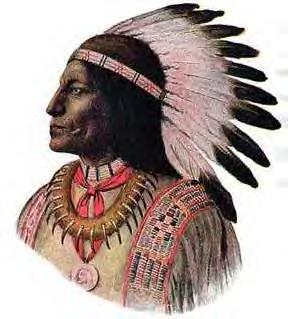|
|
The Rest of the Story
by Charles Brennan and Ben Cannon of the St. Louis Post-Dispatch
|
Commentary : Chief Pontiac, the Native American whose actions led to
the American Revolution, is buried here
Pontiac is best known today as a car, a stadium or a city in Michigan. But the original Pontiac was an Ottawa Indian born in 1720. Like others in his tribe, Pontiac enjoyed a good relationship with French settlers in the Great Lakes region who often provided Indians with gifts such as food and ammunition. When France lost American territory to Great Britain in the 1760s, the Ottawas and other Indians were forced to deal with the British. Unlike the French, the British had little use for gift giving or Indians. When poor relations with the British did not improve, Pontiac organized an alliance of tribes to fight them. Pontiac and the Ottawas were joined by the Hurons, Miamis, Delawares, Chippewas, Kickapoos, Shawnees, Potawotomis, Senecas and other tribes. This coalition turned out to be the greatest alliance against white expansion in North America. British forts fell one-by-one until the tribes captured eight forts and forced the British to abandon a ninth. Meanwhile, royal powers in Europe doomed the uprising. The French and British signed a peace treaty in the summer of 1763, which meant Pontiac could never count on any support from the French. Many of Pontiac's Indian allies abandoned the cause. Pontiac kept his own siege on Fort Detroit for six months but his prestige began to wane.The movement crumbled and Pontiac agreed to peace with the British in 1765. Although Pontiac's uprising had failed, it would change the world. In London, King George viewed Pontiac's dramatic victories over the British as a clear sign the colonies were in danger and unable to defend themselves. He decided to send troops to protect them. The king and Parliament also decided to tax the colonists to pay for the troops. Why, he asked, should the English pay for America's defense? THUS, taxes were levied on the colonists, beginning with the Stamp Act in 1765. Britain required taxes on a variety of papers and documents produced in the colonies, including newspapers. A stamp affixed to the papers was proof the tax had been paid. This was the first direct tax imposed on the Americans. Of course, riots ensued and "taxation without representation" became a slogan for the American Revolution and one of the principal offenses of the British listed in the Declaration of Independence. Pontiac, meanwhile, lived a nomadic life. During a 1769 visit to the settlement of Cahokia, Ill., Pontiac was murdered by a member of another tribe. No one knows for certain why. His remains were transported to St. Louis and are thought to be buried where the Stadium East garage stands today at the corner of Broadway and Walnut. Although the concrete and steel parking facility is well-maintained and fine for motorists, it is hardly a memorial to this great Indian chief. Instead, remembering Pontiac's contributions to U.S. history and recognizing the man who sought independence from the British before even the colonists themselves would be a more fitting tribute. Chief Pontiac COMMENTARY\Charles Brennan is a broadcaster for radio station KMOX. Ben Cannon will attend Oxford University as a Rhodes Scholar this fall. They are the authors of "Walking Historic Downtown St. Louis: 250 Incredible Years in Less than 2 Hours." |
|
|
| Canku Ota is a free Newsletter celebrating Native America, its traditions and accomplishments . We do not provide subscriber or visitor names to anyone. Some articles presented in Canku Ota may contain copyright material. We have received appropriate permissions for republishing any articles. Material appearing here is distributed without profit or monetary gain to those who have expressed an interest. This is in accordance with Title 17 U.S.C. section 107. |
|
Canku Ota is a copyright of Vicki Lockard and Paul Barry. |
|
 THOUSANDS
of visitors celebrating the nation's birthday will walk or park near a spot closely connected to the birth of our
country. No, the location is not in Boston or Philadelphia. It's here in downtown St. Louis, where Chief Pontiac
and his story have been buried for more than 200 years.
THOUSANDS
of visitors celebrating the nation's birthday will walk or park near a spot closely connected to the birth of our
country. No, the location is not in Boston or Philadelphia. It's here in downtown St. Louis, where Chief Pontiac
and his story have been buried for more than 200 years.